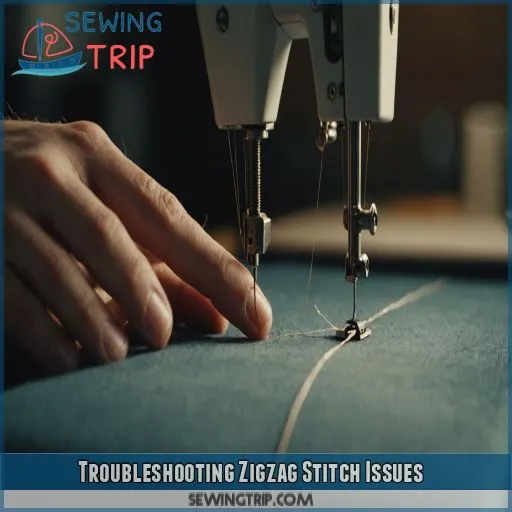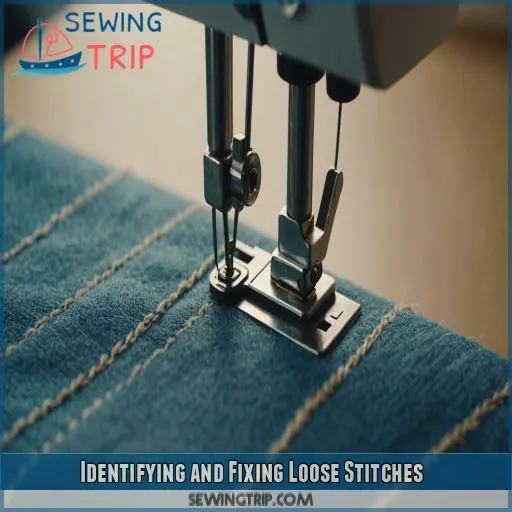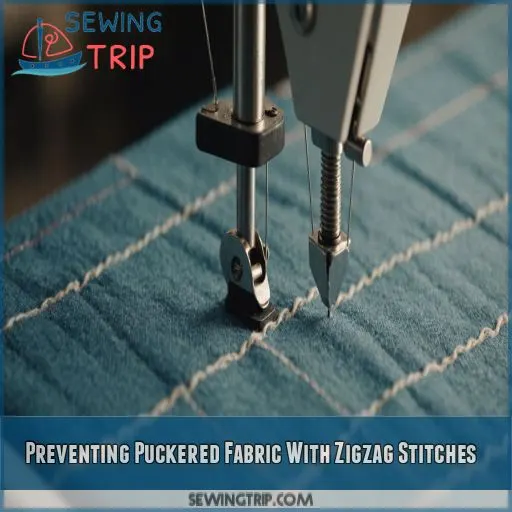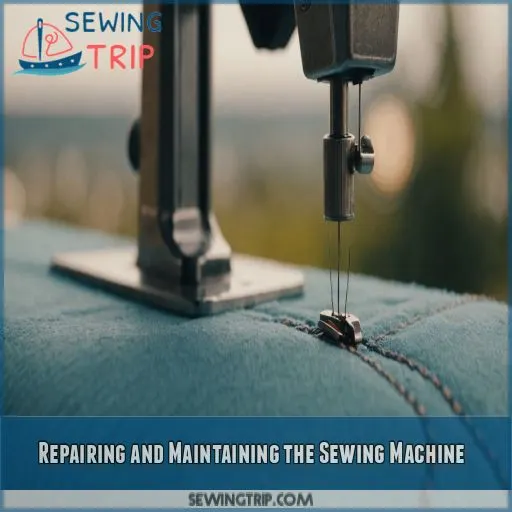This site is supported by our readers. We may earn a commission, at no cost to you, if you purchase through links.

If you’re struggling with skipped stitches, thread breakage, or puckering, don’t worry, you’re not alone.
Repairing your sewing machine’s Zigzag Stitch is easier than you think.
Start by checking your bobbin case seating and bobbin placement, then adjust your bobbin tension and confirm your threading.
If that doesn’t work, it’s time to get a little more serious with some advanced troubleshooting steps.
Let’s get that zigzag stitch back on track!
Table Of Contents
- Key Takeaways
- Troubleshooting Zigzag Stitch Issues
- Understanding Zigzag Stitch Settings
- Identifying and Fixing Loose Stitches
- Preventing Puckered Fabric With Zigzag Stitches
- Resolving Deformed Stitches and Thread Issues
- Repairing and Maintaining the Sewing Machine
- Frequently Asked Questions (FAQs)
- Conclusion
Key Takeaways
- You’re not alone in your zigzag stitch struggles – skipped stitches, thread breakage, and puckering are super common issues, but they’re also easy to fix once you know what to look for.
- Checking your bobbin case seating and bobbin placement is sewing 101, but it’s essential to get it right – a wonky bobbin can throw off your entire zigzag stitch, so take the time to consult your sewing machine’s instruction manual and get it sorted.
- Don’t be afraid to get a little more serious with some advanced troubleshooting steps – cleaning and lubricating your machine, adjusting the tension dial, and using colored threads to identify issues can make all the difference in achieving perfect zigzag stitches.
- With a little patience and know-how, you can master repairing your sewing machine’s zigzag stitch and be sewing like a pro in no time – remember to stay calm, stay patient, and don’t be afraid to experiment and try new things (and if all else fails, consult your trusty Sewing Machine manual or a professional for help).
Troubleshooting Zigzag Stitch Issues
You’re frustrated with your sewing machine’s zigzag stitch, and you’re not alone – it’s one of the most common issues sewists face. Don’t worry, with some troubleshooting and maintenance, you’ll be creating perfect zigzag stitches in no time, and we’re here to guide you through the process.
Common Problems With Zigzag Stitches
Don’t let zigzag stitch woes get the best of you! Common problems include skipped stitches, thread breakage, uneven stitches, and stitch width issues. You might also encounter fabric puckering, which can be super frustrating. The good news is that these issues are usually easy to fix. Let’s get your sewing machine humming along smoothly again!
Checking Bobbin Case Seating and Bobbin Placement
Let’s start with the basics.
Check your bobbin case seating and bobbin placement.
Make sure the bobbin is securely seated in its case and the case is properly aligned with the machine’s guides.
Consult your sewing machine instruction manual for specific guidance.
A wonky bobbin can throw off your entire zigzag stitch, so get this right and you’ll be sewing smoothly in no time!
Adjusting Bobbin Tension and Confirming Threading
Now that you’ve checked your bobbin case seating and placement, it’s time to fine-tune the tension and threading.
Adjust the bobbin tension by gently turning the screw – clockwise for tighter, counterclockwise for looser.
Then, confirm your threading is correct, using your sewing machine’s guide as a reference.
Proper tension and threading will get you closer to those perfect zigzag stitches!
Cleaning and Maintaining the Sewing Machine
To get your zigzag stitch back on track, give your sewing machine a little TLC. Cleaning and maintenance are key. Remove the needle plate and clear out any lint or thread debris that’s accumulated. Then, lubricate the components with some sewing machine oil. Here are three easy steps to follow:
- Remove the needle plate: Take out the screws and gently lift it off.
- Clear out lint and thread debris: Use a small brush or a cotton swab to sweep away any unwanted fibers.
- Lubricate the components: Apply a few drops of sewing machine oil to keep everything running smoothly.
Advanced Troubleshooting Steps
Let’s tackle those pesky zigzag stitch issues! If the basics didn’t work, it’s time to bring out the big guns. Check out these advanced troubleshooting steps:
| Step | Action | Why |
|---|---|---|
| 1 | Clean bobbin area | Lint and debris can cause issues |
| 2 | Lubricate shuttle | Reduces friction, promotes smooth stitching |
| 3 | Remove thread wrapping | Makes sure thread flows properly |
| 4 | Clean take-up area | Prevents thread tangles and breakage |
| 5 | Adjust connecting mechanism | Fixes timing issues, makes sure stitches are perfect |
Understanding Zigzag Stitch Settings
You’re one step closer to mastering the zigzag stitch – now it’s time to fine-tune your sewing machine settings. To get perfect zigzag stitches, you need to understand how to adjust your stitch width and length, create a test swatch, and balance the tension between your upper and bobbin threads.
Adjusting Stitch Width and Length
Let’s get your zigzag stitch just right. Adjusting stitch width and length is key. Here are some tips to keep in mind:
- Match stitch width to fabric type: Delicates need narrower stitches, while heavier fabrics can handle wider ones.
- Balance stitch length with density: Too long, and stitches may be too loose; too short, and they’re too tight.
- Consider seam allowance: Make sure stitches don’t encroach on your seam allowance.
- Experiment and record: Keep track of your stitch settings for future reference.
Creating a Swatch for Experimentation
To master the zigzag stitch, create a swatch for experimentation. Try different stitch widths and lengths on various fabrics, like cotton, silk, or denim. Mix and match threads to see how they interact. This hands-on approach will help you understand how your sewing machine responds to different settings, ensuring you get the perfect stitches every time.
Ensuring Balanced Tension for Zigzag Stitches
Want to nail those perfect zigzag stitches?
First things first, make sure your top and bobbin threads are playing nicely together.
This means checking your tension.
If your stitches are looking wonky, try adjusting the tension dial.
Lowering the tension number decreases the top thread’s tension, while increasing it tightens things up.
Easy peasy, right?
Now, go forth and stitch like a pro!
Consultation of Sewing Machine Manual
- Specific zigzag stitch settings: Look for any special instructions or guidelines for your machine’s zigzag stitch.
- Troubleshooting guides: Check if your manual has a troubleshooting section that can help you identify and fix common issues.
- Warranty information: Make sure you understand what’s covered under your warranty, just in case you need to make a claim.
Identifying and Fixing Loose Stitches
You’re just a thread away from achieving perfect zigzag stitches, but those pesky loose stitches on the back of your fabric are ruining the party. Don’t worry, with a few tweaks to your sewing machine’s tension and threading, you’ll be stitching like a pro in no time.
Causes of Loose Stitches on the Back of Fabric
Loose stitches on the back of your fabric? Don’t panic! It’s likely due to incorrect thread tension, a mismatched needle type, or bobbin tension issues. Perhaps it’s a threading issue or the fabric type is too thin. Identify the culprit and you’ll be on your way to tightening up those stitches and achieving sewing mastery!
Rethreading the Machine for Loose Stitches
Let’s get that machine rethreaded. You’re probably thinking, "Not again!" But don’t worry, it’s an easy fix. To rethread your machine for loose stitches:
- Check the thread path for any tangles or twists.
- Make sure the thread is seated properly in the take-up lever.
- Gently pull the thread to remove any slack.
- Give the thread a little tug to make sure it’s snug.
Adjusting Tension Dial for Upper Thread
Now that you’ve rethreaded your machine, it’s time to tweak the tension dial for the upper thread. Think of it as finding the perfect balance – not too tight, not too loose. Check your sewing machine manual for guidance on adjusting the tension dial. A well-adjusted tension dial helps create smooth stitches and prevents thread breakage.
Lowering and Increasing Tension for Desired Effect
Now that you’ve adjusted the tension dial for the upper thread, it’s time to fine-tune it for the perfect stitch. Lowering the tension number decreases the thread’s tautness, while increasing it tightens the thread. Here are some tips to achieve the desired effect:
- Start with small adjustments (0.5-1) to avoid drastic changes in stitch quality
- For delicate fabrics, lower the tension to prevent puckering
- Thicker fabrics may require higher tension for a secure stitch
- Experiment with different thread weights to find the perfect balance
- Remember, it’s all about finding the sweet spot for your specific fabric and needle size
Preventing Puckered Fabric With Zigzag Stitches
As you master the zigzag stitch, you’ll want to prevent puckered fabric from ruining your sewing projects. By understanding the causes of puckering and using simple techniques like stabilizers, heavier fabrics, or experimenting with fabric combinations, you can achieve smooth, even stitches that will make your projects look professional and polished.
Causes of Puckering and How to Prevent It
Don’t worry, it’s an easy fix. Puckering occurs when your fabric is too thin to support the density of the zigzag stitches. To prevent it, try sewing with a heavier weight fabric or using multiple layers to provide enough support. It’s all about finding that perfect balance between fabric type, stitch density, and layer thickness.
Using Stabilizers for Thin Fabrics
When working with thin fabrics, stabilizers are your best friend. Think of them as a secret ingredient that helps prevent puckering. You can use lightweight interfacing, fusible web, or even tear-away stabilizers. Place the stabilizer under your fabric, and make sure to cover the entire area where you’ll be sewing. This will give your zigzag stitches a smooth finish.
Sewing With Heavier Weight Fabrics
Give your zigzag stitches a fighting chance by switching to heavier weight fabrics! Thicker fabrics provide the necessary support for dense zigzag stitches, reducing puckering. Just be sure to adjust your needle size and machine pressure accordingly. A heavier fabric also means you can dial up the foot pressure and stitch length for a more dramatic effect.
Experimenting With Fabric Combinations
Now that you’ve tried sewing with heavier weight fabrics, it’s time to get creative with fabric combinations! Experiment with blending textures, colors, and weights to achieve the perfect drape effect. Remember, stitch density is really important, so adjust your zigzag stitch settings accordingly. By mixing and matching fabrics, you’ll master the art of preventing puckered fabric and achieve professional-looking results.
Resolving Deformed Stitches and Thread Issues
You’re one step closer to becoming a zigzag stitch master – now it’s time to tackle those pesky deformed stitches and thread issues that can quickly ruin your sewing vibe. In this section, you’ll learn how to identify and fix these problems by adjusting your tension dial, using colored threads, and consulting your trusty sewing machine manual for personalized guidance.
Identifying Deformed Stitches and Thread Tension Issues
You’re tackling deformed stitches and thread tension issues – the ultimate sewing machine puzzle! Don’t worry, it’s not as hard as it seems. To identify the culprit, check if your stitches resemble "Ys" on the back of the fabric. This usually indicates a thread tension imbalance. Grab a magnifying glass and inspect those stitches closely.
Adjusting Tension Dial for Balanced Tension
Let’s get that tension just right. Adjust the tension dial to achieve a balanced tension between the upper and bobbin threads. Think of it like a seesaw: when the top thread is too tight, the bottom thread is too loose, and vice versa. Experiment with different thread types and needle sizes to find the perfect harmony for your zigzag stitch.
Using Colored Threads for Easy Identification
The detective work begins! To identify deformed stitches, try using colored threads. Thread your machine with two different colors – one for the top thread and another for the bobbin thread. This color-coding trick helps you spot issues with thread tension and makes adjustments a breeze. Trust us, it’s a game-changer for achieving perfect zigzag stitches!
Consulting Sewing Machine Manual for Tension Adjustments
Now that you’re using colored threads to identify the top and bobbin threads, it’s time to consult your sewing machine manual for specific tension adjustments. Don’t worry, it’s not as painful as it sounds! Look for guidelines on tension dial settings, thread types, and bobbin thread adjustments to fine-tune your machine’s calibration and get perfect stitches.
Repairing and Maintaining the Sewing Machine
You’re about to become a sewing machine whisperer! To keep your trusty machine purring smoothly and producing perfect zigzag stitches, you’ll need to perform some routine maintenance and repairs, like replacing damaged needles, cleaning and lubricating components, and resetting the timing.
Replacing Damaged Needles and Preventing Breakage
Time to give your sewing machine needle some TLC! Regularly inspect it for damage, as a bent or worn-out needle can cause top thread breakage, especially when sewing through thick layers.
Look out for signs like skipped stitches, uneven tension, or a crunching sound. These are all indicators that your needle may be damaged and in need of replacement.
Replace your needle every 8-10 hours of use to prevent breakage and keep your zigzag stitches perfect!
Regular Inspection and Maintenance of the Sewing Machine
- Check the needle for damage or wear
- Inspect the bobbin case for debris or lint
- Look for signs of wear on the presser foot
- Check the tension discs for thread buildup
- Make sure the machine is properly threaded
Cleaning and Lubricating Machine Components
Now that you’re in the habit of regularly inspecting your sewing machine, it’s time to give it a good cleaning and lubricating. Think of it as a spa day for your machine! Use a soft brush to remove dust and debris, then apply a few drops of machine oil to the designated areas.
| Component | Cleaning Solution |
|---|---|
| Bobbin area | Soft brush and mild soap |
| Presser foot | Damp cloth and gentle scrub |
| Feed dogs | Brush and machine oil |
| Take-up lever | Soft cloth and machine oil |
Remember to use the right machine oil type for your sewing machine, and apply it sparingly to avoid attracting dust.
Resetting Timing and Adjusting Tension for Optimal Performance
Now that you’ve cleaned and lubricated your machine, it’s time to fine-tune its performance. To get your zigzag stitch just right, you may need to reset the timing and adjust the tension.
- Check your sewing machine manual for specific guidance on resetting the timing.
- Adjust the tension discs to make sure the bobbin thread is controlled properly.
- If issues persist, consult a professional for help with shuttle hook timing and sewing machine calibration.
Frequently Asked Questions (FAQs)
Why won’t my sewing machine zigzag stitch?
Hey there, sewer extraordinaire! If your zigzag stitch is MIA, check your bobbin case seating, adjust the tension, and confirm correct threading. A worn needle or clogged machine might also be the culprit
What settings should your sewing machine be on for a zig zag stitch?
Think of your sewing machine as a dance partner – to master the zigzag stitch, you need to find the perfect rhythm! Set your machine to a medium stitch length and width, and adjust the tension dials for a smooth, even stitch.
Why is my sewing machine skipping zigzag stitches?
Don’t worry, friend! If your sewing machine is skipping zigzag stitches, it’s likely due to a simple issue like incorrect threading, worn-out needle, or imbalanced tension (Source). Check these basics first, and you’ll be sewing smoothly in no time!
How do you stop a zig zag stitch from puckering?
To stop zig zag stitches from puckering, try using a stabilizer like lightweight interfacing or sewing with heavier weight fabric. Experiment with different fabric combos to find the perfect balance for a smooth, pucker-free stitch!
How often should I clean my sewing machine for optimal zigzag stitch performance?
Think of your sewing machine as a high-performance sports car – it needs regular tune-ups to run smoothly! Clean your machine every 1-3 months, or after 10-15 hours of use, to keep your zigzag stitch in top gear.
Can I use any type of thread for zigzag stitches on my sewing machine?
Hey there, sewer extraordinaire! For zigzag stitches, not all threads are created equal. Use a high-quality, cotton or polyester thread that’s designed for sewing machines, and avoid using too-thin or too-thick threads.
Why does my sewing machines zigzag stitch only work on certain fabrics?
Don’t worry, friend! If your sewing machine’s zigzag stitch only works on certain fabrics, it’s likely due to incorrect thread tension, a dull needle, or inadequate fabric support – try adjusting these and see the magic happen! (Source)
Can I adjust the zigzag stitch length and width on my sewing machine?
Like a master chef fine-tuning a recipe, you can adjust the zigzag stitch length and width on your sewing machine to suit your fabric and project needs – simply consult your machine’s manual for specific instructions!
What are the benefits of using a stabilizer with zigzag stitches on thin fabrics?
Using a stabilizer with zigzag stitches on thin fabrics is a game-changer! It helps prevent puckering and gives your stitches a smooth, even finish. You’ll achieve professional-looking results and reduce frustration – a win-win!
Conclusion
Take Emily, an avid quilter, who was on the verge of ditching her sewing machine due to pesky zigzag stitch issues.
But after tweaking her bobbin tension and threading, she was back to creating stunning quilts.
By following these steps, you can also master repairing your sewing machine’s zigzag stitch.
Don’t let skipped stitches or puckering get in the way – with a little patience and know-how, you’ll be sewing like a pro, effortlessly repairing your sewing machine zigzag stitch.












